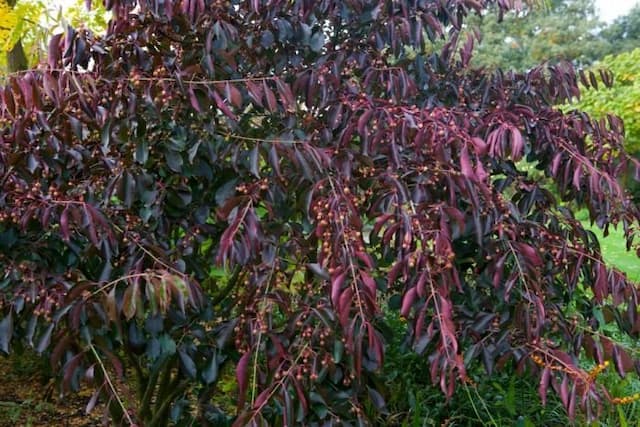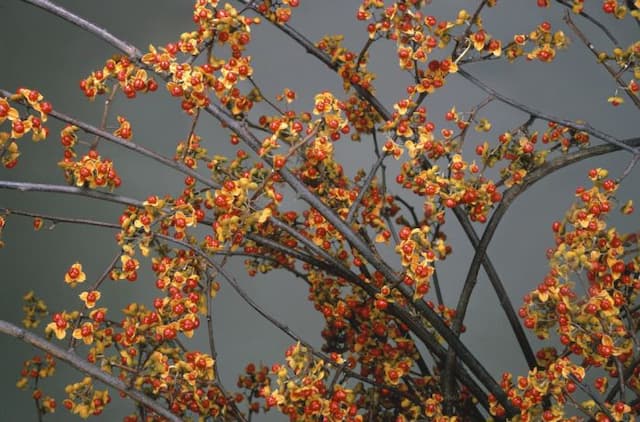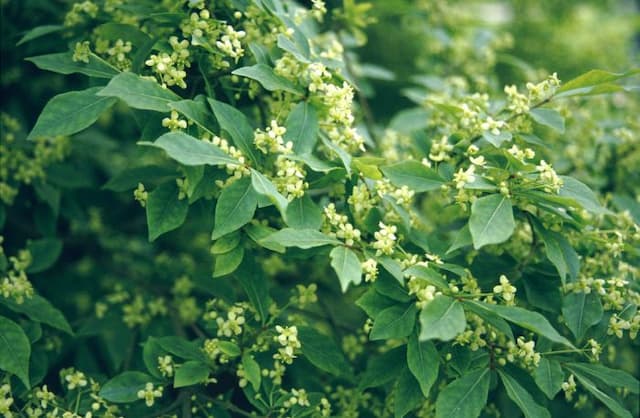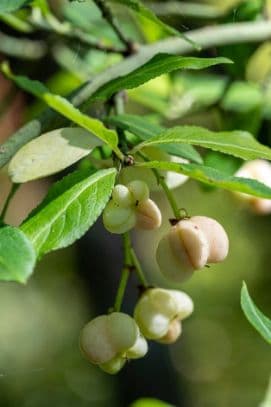Golden Japanese Spindle Euonymus japonicus 'Aureus' (v)
ABOUT
The Euonymus japonicus 'Aureus', commonly known as the Golden Japanese Spindle, is an ornamental evergreen shrub known for its striking foliage. The leaves are eye-catching, characterized by their glossy, leathery texture. Each leaf exhibits a beautiful variegation pattern where the central portion of the leaf is a bright golden yellow, which gracefully blends into the green edges. This contrast of gold and green gives the plant a vibrant, shimmering appearance, especially when it catches the light. The Golden Japanese Spindle maintains a dense, bushy form with a tightly packed arrangement of leaves along its branches. Its overall shape contributes to its popularity as a hedging or topiary plant in gardens and landscapes. During the warmer seasons, it can produce inconspicuous greenish-white flowers that are small and not particularly showy compared to the foliage. These may sometimes develop into spindle-shaped, pinkish fruit that adds an additional point of interest on the plant. Overall, the Golden Japanese Spindle's appearance is distinguished by its lustrous variegated leaves that make it a visually appealing choice for both formal and informal garden settings. Its evergreen nature ensures year-round color and structure in the garden, making it a valuable plant for gardeners seeking consistent garden interest without concern for seasonal leaf drop.
About this plant
 Names
NamesFamily
Celastraceae.
Synonyms
Golden Japanese Spindle, Golden Euonymus, Japanese Spindle 'Aureomarginatus', Variegated Japanese Spindle.
Common names
Euonymus japonicus 'Aureomarginatus', Euonymus japonicus var. aureopictus.
 Toxicity
ToxicityTo humans
The Japanese spindle is considered toxic if ingested. All parts of the plant contain alkaloids that can cause gastrointestinal distress, including symptoms like nausea, vomiting, diarrhea, abdominal pain, and cramping. In severe cases, ingesting large amounts of the plant can possibly lead to more serious symptoms such as weakness, chills, convulsions, and rapid heart rate. It is essential to seek medical attention if ingestion is suspected.
To pets
The Japanese spindle is toxic to pets, such as cats and dogs. Consuming any portion of the plant can result in symptoms similar to those in humans, typically including vomiting, diarrhea, weakness, and abdominal pain. In severe cases, symptoms can escalate to cardiac problems, convulsions, and potentially life-threatening conditions. If a pet ingests this plant, it is imperative to contact a veterinarian immediately.
 Characteristics
CharacteristicsLife cycle
Perennials
Foliage type
Evergreen
Color of leaves
Variegated
Height
6 feet (1.83 meters)
Spread
6 feet (1.83 meters)
Plant type
Shrub
Hardiness zones
6
Native area
Japan
Benefits
 General Benefits
General Benefits- Ornamental Appeal: Japanese Spindle 'Aureus' has variegated leaves that add visual interest to gardens.
- Low Maintenance: It requires minimal care once established, making it suitable for busy gardeners.
- Drought Tolerance: Once established, it can tolerate dry conditions, reducing the need for frequent watering.
- Versatility: Suitable for a variety of landscaping uses, including hedges, topiary, or as a specimen plant.
- Evergreen: It retains its foliage year-round, providing constant greenery in the garden.
- Pest Resistance: Generally resistant to pests, reducing the need for chemical treatments.
- Hardiness: It is hardy in a range of climate zones, which can make it a good choice for different gardens.
- Soil Adaptability: It can thrive in a variety of soil types, though it prefers well-draining conditions.
- Privacy: When grown as a hedge, it can provide privacy and reduce noise from surroundings.
- Wildlife Support: It can attract birds that feed on its fruits or use it for shelter.
 Medical Properties
Medical PropertiesThis plant is not used for medical purposes.
 Air-purifying Qualities
Air-purifying QualitiesThis plant is not specifically known for air purifying qualities.
 Other Uses
Other Uses- Japanese Spindle can be used as a canvas for topiary art, where the shrubs are trimmed into geometric shapes, animals, or other intricate designs due to their dense foliage.
- Japanese Spindle wood, being hard and dense, is suitable for making small wooden objects such as tool handles, fine furniture, or intricate carvings.
- The dense foliage of the Japanese Spindle can act as a natural sound barrier when planted in rows alongside busy streets or between properties.
- Because of its compact growth, it can be used in model landscapes, such as train dioramas or architectural models, to represent trees or hedges at a smaller scale.
- The plant can serve as a living fence or privacy screen when grown in tight rows, providing year-round privacy due to its evergreen nature.
- Japanese Spindle is effective in preventing soil erosion when planted on slopes or banks because its roots help to stabilize the soil.
- It can be used in bonsai culture, offering a challenge for gardeners due to its relatively fast growth and need for consistent shaping.
- In wind-prone areas, Japanese Spindle hedges can act as windbreaks, protecting more delicate plants in the garden.
- The plant can be used as a green dye source where the leaves are processed to extract natural colorants for textile dyeing.
- It can serve as an indicator plant for monitoring environmental conditions like air quality and soil fertility, as it may show specific symptoms in response to pollutants or deficiencies.
Interesting Facts
 Feng Shui
Feng ShuiThe Japanese Spindle is not used in Feng Shui practice.
 Zodiac Sign Compitability
Zodiac Sign CompitabilityThe Japanese Spindle is not used in astrology practice.
 Plant Symbolism
Plant Symbolism- Versatility: Euonymus japonicus 'Aureus', commonly known as the Japanese spindle, is an adaptable shrub that can thrive in a variety of conditions, symbolizing flexibility and resilience in different life circumstances.
- Longevity: This plant is known for its ability to live for many years, often symbolizing long life and endurance.
- Growth: With its evergreen nature and consistent growth, the Japanese spindle represents continual personal growth and development.
- Protection: Sometimes used in hedges, the Japanese spindle can symbolize setting boundaries and protecting oneself from external influences.
- Good Fortune: In some cultures, evergreen plants like the Japanese spindle are considered to bring luck and prosperity to the home.
 Water
WaterFor Japanese Spindle 'Aureus', watering should be done to keep the soil evenly moist but not soggy. Generally, watering once a week with about one to two gallons of water is sufficient, but this may need to be adjusted depending on the climate and weather conditions. It's important to water the plant deeply, allowing moisture to reach the roots, rather than just wetting the surface. During hot, dry periods, you may need to water more frequently, whereas in cooler or rainy seasons, less frequent watering may be required. Always check the top inch of the soil for dryness before watering.
 Light
LightJapanese Spindle 'Aureus' thrives in a location that receives full to partial sunlight. The best spot for this plant would be where it can get at least four to six hours of direct sunlight a day, but it also tolerates some shade. Be cautious of too much intense afternoon sun in hotter climates as it may scorch the foliage, and ensure the plant has some protection or filtered light during these times.
 Temperature
TemperatureThe Japanese Spindle 'Aureus' prefers moderate temperatures and can withstand a range from 30 to 90 degrees Fahrenheit. However, the ideal temperature range for this plant is between 60 to 80 degrees Fahrenheit. Protect the plant from extreme cold by providing insulation or moving it indoors if it is in a container, and similarly shield it from intense heat during the hottest part of the day.
 Pruning
PruningPrune Japanese Spindle 'Aureus' to maintain shape and encourage bushier growth. Pruning should be done in late winter or early spring before new growth begins. It's usually enough to prune once a year, but if the plant is used for hedging, more frequent trimming may be needed to keep a neat appearance. Always remove any dead or damaged branches when you notice them to keep the plant healthy.
 Cleaning
CleaningAs needed
 Soil
SoilGolden Euonymus thrives in well-draining, loamy soil with a pH range of 6.0 to 8.0. A suitable mix would include garden soil, peat, and perlite to ensure good drainage and aeration. Regularly check the soil pH to maintain optimal conditions for the plant's growth.
 Repotting
RepottingGolden Euonymus should generally be repotted every 2 to 3 years to prevent root-bound conditions and to replenish its soil nutrients. Choose a slightly larger pot when repotting to accommodate root growth.
 Humidity & Misting
Humidity & MistingGolden Euonymus prefers moderate humidity levels, around 40-50%, which generally corresponds to typical indoor conditions. No specific high humidity is needed for this hardy shrub.
 Suitable locations
Suitable locationsIndoor
Place in bright, indirect light, & don't overwater.
Outdoor
Plant in well-drained soil, partial to full sun.
Hardiness zone
6-9 USDA
 Life cycle
Life cycleJapanese Spindle 'Aureus' begins its life as a seed which germinates in favorable conditions of warmth and moisture, often in spring or early summer. After germination, the seedling emerges and establishes itself, growing into a juvenile plant with characteristic green and gold variegated leaves. As it matures, it enters a vegetative stage where it focuses on leaf and stem growth, forming a dense, bushy shrub. This is followed by the reproductive phase, during which the plant blooms with small, inconspicuous greenish-white flowers, usually appearing in late spring or early summer. After pollination, it produces a fruit that is a small, pink to red capsule containing seeds, which, when mature, are dispersed to start a new lifecycle. The plant then continues to grow and can live for many years, often requiring pruning to maintain shape and promote vigorous growth.
 Propogation
PropogationPropogation time
Late Spring-Early Summer
Propogation: The most popular method of propagating Japanese Spindle 'Aureus' is through semi-hardwood cuttings. This is typically done in the late summer or early fall. To propagate, a cutting of about 4 to 6 inches (10 to 15 centimeters) long is taken from a healthy parent plant, ensuring it has several leaves. The lower leaves are removed, and the cut end may be dipped in a rooting hormone powder to encourage root development. Then, the cutting is planted in a well-draining rooting medium and kept moist until roots have developed, which can take a few weeks. Once rooted, the cutting can be transplanted to a more permanent location.






![Spindle [Blondy]](/_next/image?url=https%3A%2F%2Fplants-admin.emdemapps.com%2Fimages%2Fplants%2F%2Fimages%2F604b642f54add.png&w=640&q=75)
